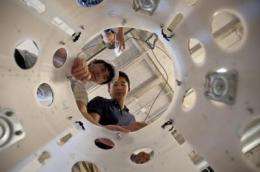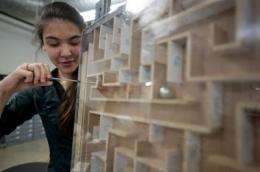Feeding without the frenzy: Researchers engineer devices for Houston Zoo to feed giraffes, orangutans

Like their human cousins, orangutans enjoy food and don't mind working a little to get it. If the menu's right, giraffes are even less picky.
Two teams of students at Rice University's George R. Brown School of Engineering have designed devices to efficiently, durably, safely and inexpensively meet the feeding needs of these very different residents of the Houston Zoo.
"For the orangutans, we wanted to make it like a puzzle," said Julia Bleck, a junior majoring in mechanical engineering who got involved with the project through the Rice Center for Engineering Leadership. "They have mental skills similar to those of humans and learn things pretty quickly, and know how to be patient. We wanted to keep it interesting for them."
Bleck is the apprentice leader of The Buffoonery, a team name taken from the collective noun used to describe a group of orangutans. Other team members are freshmen Reinaldo Amendola-Mayorga, Jade Juzswik, Jake LaViola and Greta Shwachman.
"The primate people at the zoo wanted something that would give the orangutans not just food but daily mental enrichment," Bleck said.
Last fall the team started with more than 60 possible designs but quickly settled on the idea of a maze. By solving the maze, the Houston Zoo's six orangutans would be rewarded with nuts or the food pellets they enjoy as a supplement to their customary fruits and vegetables. The team's prototype is a flat box of high-impact plastic, transparent on one side. Inside is an elaborate maze of wooden slats holding a ball bearing.
With a magnet, an orangutan moves the steel ball through the maze. If the animal navigates the maze successfully, the ball trips a lever and releases a measured portion of pellets.
The other zoo project is the creation of Team Koolookamba. All of its members are freshmen: Sarah Frazier, Adam McMullen, Andrew Markham, Joseph Mapula and Calvin Tsay. Allison Garza, a junior mechanical engineering student, was the team's apprentice leader.
Their challenge was to design a feeder for giraffes that is safe and prevents the animals from consuming the hay it contains too quickly.

"They already feed the giraffes things like yams and fruit, and up till now they've been putting the hay in cargo-net feeders," Frazier said. "The animals get their horns stuck in the net, and they eat the hay too fast."
Using plastic pipe, the team made a barrel-like cylinder about 4 feet long and cut 3-inch circular holes into it. Filled, the barrel device holds about 7,500 cubic inches of hay. Giraffes use their tongues to grasp their food, and the small holes prevent them from quickly emptying the contents. The feeders are suspended 10 to 13 feet above the ground by winches attached to a wooden pole.
"The students worked hard on a design that met the goals of challenging the giraffes to work to get their food from the feeder and making it convenient for the keepers to get the food into it," said John Register, the zoo's hoofed stock supervisor. "They did several prototypes and tested them on our giraffe herd. We're happy with the final design and plan to use it."
Provided by Rice University


















